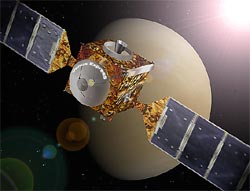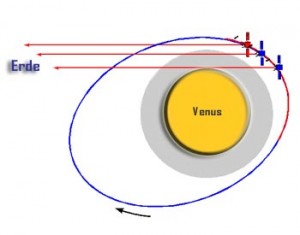
Source: ESA
The spacecraft Venus Express was successfully launched on the 9th of November in 2005 at the space mission launch center Baikonur in Kazakhstan with a Russian Soyuz-Fregat rocket. 153 days after launch it swung into an orbit around the planet Venus to start the observing mission. It was planned for Venus Express to observe the planet for approx two Venus years which corresponds to 500 Earth days. In the end the spacecraft was active until the end of the year 2013 and has provided much information about the planet Venus.
The first phase of investigation of the planet Venus by spacecrafts (1962-1985) was carried out by the missions Venera, Pioneer Venus and Vega which provided first descriptions of the physical and chemical conditions which dominate in the atmosphere and on the surface of Venus.
However there also arose many questions about the physical processes which lead to these conditions. A good part of this questions are unanswered until today. Extensive radar mappings through Venera 15 and 16 and the Magellan-Orbiter, combined with few pictures derived from landers, have considerably extended our knowledge about the geology and the geophysics on Venus. Now a similar systematic investigation is to be happen. In particular this hold good for the atmosphere beneath the clouds because there is almost no proper data considering this region until now. Many problems which are associated with the interaction between Venus’ atmosphere and the Solar wind are not yet solved. The basic secrets of Venus are associated with:
- the global atmospheric circulation
- the atmospheric chemical composition and it's changes
- the interactions between the surface atmosphere and the planets surface including volcanism
- the physics and chemistry of the cloud layers
- the role of the trace gases for the greenhouse effect
- the origin and development of the atmosphere
- the plasma environment and it's dependence of the solar wind
Durch einen leistungsfähigen Orbiter, ausgerüstet mit Fernerkundungs- und in-situ -Messgeräten, können diese grundlegenden Geheimnisse der Venus gelüftet werden. Der Vergleich mit früheren Raumfahrzeugmissionen lässt einen Durchbruch erwarten, indem die spektralen ‚Fenster‘ im nahen Infrarotspektrum der Venus-Nachtseite ausgenutzt werden. Diese wurden erst in den späten achtziger Jahren entdeckt: Strahlung der unteren Atmosphäre und der Oberfläche entweicht ins All und kann gemessen werden. Somit ermöglicht eine Kombination von Spektrometern und Kameras, welche den gesamten Bereich vom UV bis hin zum thermalen IR-Bereich abdecken, zusammen mit anderen Instrumenten wie Radar und einem Plasmaanalysator, eine Sondierung der gesamten Venusatmosphäre von der Oberfläche bis zu 200 km Höhe; außerdem können noch zusätzliche Informationen über die Oberfläche gesammelt werden, welche die Magellan-Mission vervollständigen würde.
The instruments developed for Mars Express and Rosetta suit also for the purposes of Venus Express. The following instruments are part of the actual load of Venus Express:
- SPICAV: multifunctional UV-IR spectrometer for solar/stellar occultations and nadir-observations
- PFS: hight resolution Fourier spectrometer
- ASPERA: ‚Energetic Neutral Atom (ENA) imaging‘ zur Visualisierung geladener und neutraler Gasumgebungen
- VIRTIS: sensibler optischer ’spectro-imager‘ und mid-IR Spektrometer
- VeRa: Radio-Science ecperiment
- VMCwide angle camera
- MAGmagnetic field measurements
VeRa – Venus Express Radio Science

The direct radio contact between spacecraft and the ground station on Earth is used for the radio sounding of neutral and media.
The scientific aims of the Venus Radio Science Experiment (VeRa) are:
(1)Radio sounding of Venus’ ionosphere,

from ~ 80 km altitude to the ionopause (300 km to 600 km altitude depending of the state of the solar wind), in dependence of planetary latitude and solar wind to:
- deduce vertical profiles of the electron density,
- determine the height of the ionopause,
- study the interaction of the solar wind with Venus' ionosphere as a function of local time
2) Radio sounding of the neutral atmosphere from the cloud cover (35 – 40 km) up to 100 km altitude to deduce vertical profiles of the neutral mass density, the temperature and the pressure in dependence of the planetary latitude and the season as functions of local time.

(3)Measurements of the electric features,
roughness and chemical composition of Venus’ surface using the reflection of radio waves on the surface (bistatic radar experiment),
(4) Studies of the coronal structure and the solar wind turbulence during the upper and the lower conjunction of Venus around the Sun. For terrestrial planets one distinguishes between upper and lower conjunction, i.e. the planet resides on a line: planet-Sun-Earth (upper conjunction) or Sun-planet-Earth (lower conjunction).
VeRa uses the radio carrier signal of the spacecraft in the X-band (8.4 GHz) and in the S-band (2.3 GHz) which are transferred simultaneously by the high gain antenna (HGA).
See also: